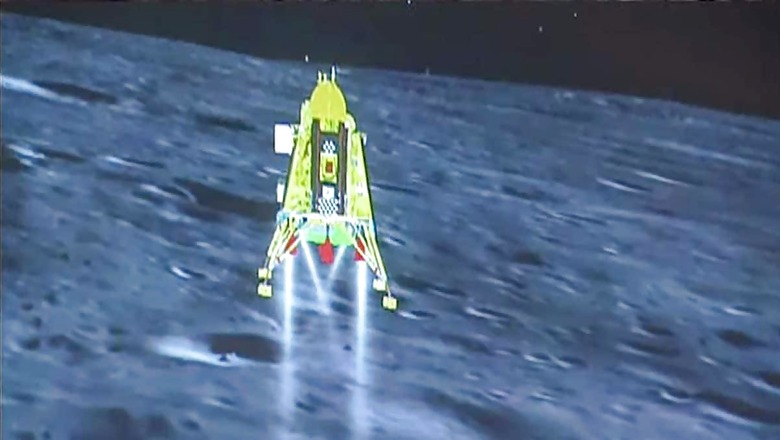
views
India moonwalked into history on Wednesday, becoming the first country to reach the uncharted south pole of Earth’s only natural satellite, as the Chandrayaan-3 lander module, carrying advanced scientific equipment as well as the hopes and dreams of a 140-crore-strong nation, touched down on the lunar surface.
With this momentous achievement, India also became the fourth country to master the technology of soft landing on the moon after the United States, China, and the erstwhile Soviet Union.

Less than a week after Russia’s Luna-25 mission failed, the Chandrayaan-3 spacecraft landed on the lunar south pole around 6.04 pm (IST) on Wednesday, ending an agonising wait for Indian Space Research Organisation (ISRO) scientists as well as millions in India and across the world.
Chandrayaan-3 Mission:'India????????,I reached my destinationand you too!': Chandrayaan-3Chandrayaan-3 has successfullysoft-landed on the moon ????!.
Congratulations, India????????!#Chandrayaan_3#Ch3
— ISRO (@isro) August 23, 2023
Prime Minister Narendra Modi, who is in South Africa for the BRICS summit, joined ISRO virtually for the final phases of Chandrayaan-3’s journey. Calling it the “dawn of a new era”, he congratulated India after the Vikram lander successfully touched down on the moon’s south pole.
“This moment is precious and unprecedented. This moment is the ‘jaighosh’ of new India. This moment is the strength of 1.4 billion heartbeats, Amrit Varsha in this phase of Amrit Kaal,” said the PM, in an online address to the nation from South Africa, as beaming scientists and technicians celebrated at ISRO’s headquarters in Bengaluru.
Historic day for India's space sector. Congratulations to @isro for the remarkable success of Chandrayaan-3 lunar mission. https://t.co/F1UrgJklfp— Narendra Modi (@narendramodi) August 23, 2023
“We are all very jubilant,” ISRO chairman S Somanath said in an exclusive chat with News18. “We were all very confident of the soft landing…It was a flawless landing…Chandrayaan journey started with Chandrayaan 1…It’s a journey of so many years.”
People crowded around televisions and giant screens in offices, shops, restaurants and homes while thousands prayed for the success of the mission at religious places and also with oil lamps on river banks, including in the holy city of Varanasi. Many schools held special live screenings of the historic event for children.
The mission is aimed at examining the southern polar region of the moon, which has water ice or frozen water that could be a source of oxygen, fuel, and water for future lunar explorations or a more permanent moon colony.
After landing successfully, the Chandrayaan-3 is expected to remain functional for two weeks, running a series of experiments, including a spectrometer analysis of the mineral composition of the lunar surface.
The Chandrayaan mission, also known as the Indian lunar exploration programme, involves a series of space missions conducted by ISRO. The first mission, Chandrayaan-1, was launched in 2008 and successfully entered lunar orbit.
Chandrayaan-2 failed in its lunar phase when its lander Vikram crashed into the surface of the moon following anomalies in the braking system while attempting a touchdown on September 7, 2019.
Chandrayaan-3 is a follow-on mission to Chandrayaan-2 and its objectives are to demonstrate safe and soft landing on the lunar surface, roving on the moon, and to conduct in-situ scientific experiments.
With an estimated budget of Rs 615 crore, Chandrayaan-3 is one of India’s most cost-effective space missions. It is cheaper than its predecessor, Chandrayaan-2, and costs far less than many big-budget films.
The Chandrayaan-3 mission was launched on July 14 onboard Launch Vehicle Mark-III (LVM-3) rocket, for a 41-day voyage to reach near the lunar south pole.
ISRO had shown the first glimpse of the third moon mission in April last year. The launch was earlier scheduled to take place in 2020, but it was delayed due to the Covid-19 pandemic.
Learning from its past instance, ISRO implemented several improvements in Chandrayaan-3 to ensure success this time.
The spacecraft consisted of three parts: a lander module (LM), a propulsion module (PM), and a rover. The lander had the capability to soft-land at a specified lunar site and deploy the rover which will carry out research on the lunar surface. The main function of the propulsion module was to carry the lander module from the launch vehicle injection to the final lunar 100 km circular polar orbit.
Vikram, the lander’s name, honours Vikram Sarabhai, the visionary behind India’s space endeavours. His legacy includes founding ISRO, elevating India to space exploration. His name symbolises progress.
Pragyan, the rover’s moniker, signifies wisdom. It operates post-landing, collecting data from five scientific instruments onboard the lander and rover.
Chandrayaan-3 took off from the Satish Dhawan Space Centre in Andhra Pradesh from the Geosynchronous Satellite Launch Vehicle Mark III (GSLV-MK III) heavy-lift rocket on July 14, 2023.
The significance of the mission is that the propulsion module has a payload, SHAPE or Spectro-polarimetry of Habitable Planet Earth, to study Earth from lunar orbit.
After the launch on July 14, Chandrayaan-3 conducted a series of manoeuvres to gradually move the spacecraft into higher and higher orbits before beginning to move directly towards the moon. The Earth-bound manoeuvres went on till July 31 after which the craft moved into translunar orbit.
Chandrayaan-3 performed the Trans Lunar Injection (TLI), a propulsive manoeuvre to slingshot the spacecraft towards the moon from Earth’s orbit on August 1. The propulsive manoeuvre sent the lunar craft on a trajectory towards the moon.
Chandrayaan-3 entered into the lunar orbit on August 5, following which orbit reduction manoeuvres were carried out on August 6, 9, 14 and 16.
On August 16, ISRO successfully carried out the fifth and final orbit reduction manoeuvre.
The Chandrayaan-3 Lander Module (LM), comprising the Vikram lander and the Pragyan rover, successfully separated from the propulsion module on August 17.
After separation, the lander underwent a “deboost” (the process of slowing down) to place it in an orbit where the perilune, the closest point to the moon, is 30 kilometres, and apolune, the farthest point from the moon, is 100 km.
After the second and final deboosting operation on August 20, the landing module was placed in a 25 km x 134 km orbit around the moon. Finally, the touchdown of the lander was successfully attempted on August 23 at 6.04 pm.
India’s feat comes at a time when major space-faring countries are returning to the moon after 50 years in pursuit of water and critical minerals locked in the lunar exosphere and surface.
The moon, which is 3,84,400 km from our planet, moderates the Earth’s wobble on its axis which ensures a more stable climate. It also causes tides in the world’s oceans. Current thinking is that it was formed when a massive thing collided with the Earth about 4.5 billion years ago. The debris from the collision came together to form the moon.
(with agency inputs)


















Comments
0 comment